New Battle of Midway pits military history against wildlife
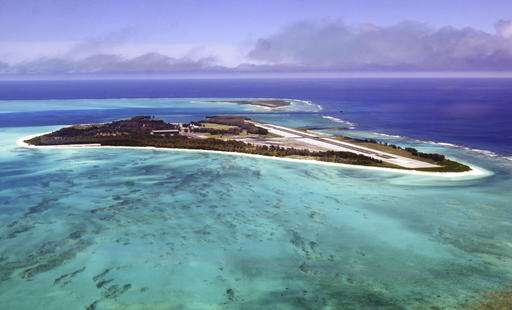
MIDWAY ATOLL, Northwestern Hawaiian Islands (AP)—The Battle of Midway was a major turning point in World War II's Pacific theater. The remote atoll where thousands died is now a delicate sanctuary for millions of seabirds, and a new battle is pitting preservation of its vaunted military history against the protection of its wildlife.
Halfway between the United States and Asia, Midway's three islets are surrounded by vibrant coral reefs and are home to the biggest colony of Laysan albatrosses on Earth. The large, white and black seabirds pair off and mate for life, nesting and raising their young on Midway.
President Barrack Obama recently traveled here to announce the expansion of the Papahanaumokuakea Marine National Monument, now the world's biggest oceanic preserve.
"I look forward to knowing that 20 years from now, 40 years from now, 100 years from now, this is a place where people can still come to and see what a place like this looks like when it's not overcrowded and destroyed by human populations," Obama said.
The atoll is a place where many people have lived, and perished—almost 3,000 in the historic conflict with Japan. And the public has not been allowed to visit the refuge or the battle monuments for years.
Midway is now a mix of boarded-up buildings left over from the island's military heyday and freshly painted facilities still in use by the U.S. Fish and Wildlife Service.
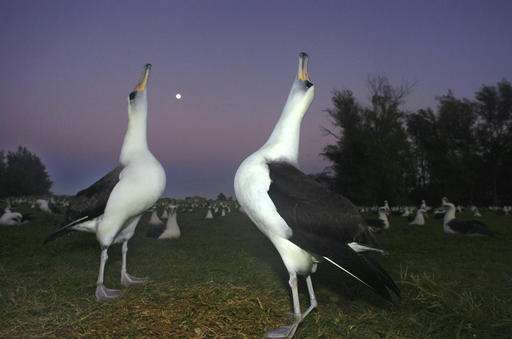
"Fish and Wildlife has every right and obligation to protect the wildlife, but they also have an obligation to protect the historic sites and the meaning of Midway," said James D'Angelo, founder of the International Midway Memorial Foundation. "It is precisely because of the men that lived and died that that memory should never be forgotten."
Six months after the Pearl Harbor attack, American forces turned away the Japanese at Midway and went on the offensive. In all, 2,500 Japanese and 307 Americans were killed in the battle.
The Midway Atoll National Wildlife Refuge was established in 1988 when the atoll was still under Navy control. In 1996, management was transferred to the wildlife agency with a mandate to maintain and preserve not only the wildlife but the atoll's historical significance.
Since 2000, the site has been designated as a National Memorial to the Battle of Midway. The original seaplane hangar is deeply rusted and has shrapnel pockmarks. Behind it, a huge pile of desks, bicycles, rusting metal and broken speedboat engines await removal.
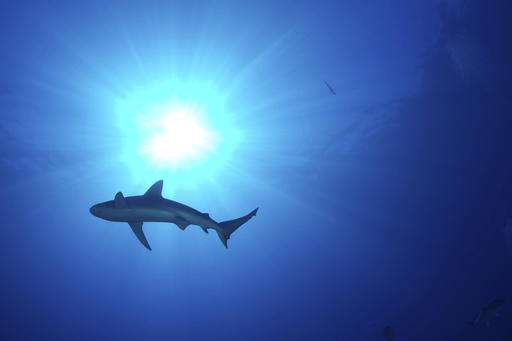
Midway sits amid a collection of man-made debris called the Great Pacific Garbage Patch. Along Midway's paths lay piles of feathers with rings of plastic in the middle—remnants of birds that died with the plastic in their guts. Each year the agency removes about 20 tons of plastic and debris that washes ashore from surrounding waters.
The critically endangered short-tailed albatross can be found only on Midway and one other small Pacific island. Endangered Hawaiian monk seals and green sea turtles also frequent Midway's shores.
In 1996, the government reached an agreement with the Georgia-based Phoenix Midway Corp. to help operate the island's visitor program, with lodging, a restaurant, a dive shop and bowling alley, at no cost to taxpayers.
But, in its six years of operation, the company had only one profitable month, according to a document submitted to the Fish and Wildlife Service and provided to The Associated Press by the memorial foundation.
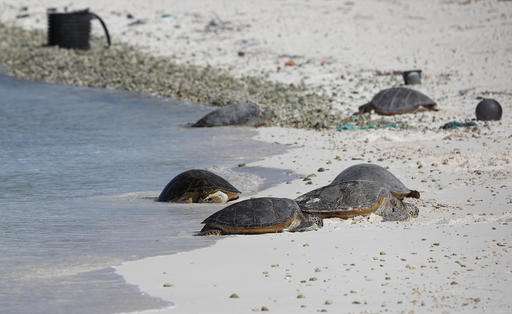
In mid-2001, the company pulled out. After that, there was either no visitor program or a limited one.
"It's financial suicide for anybody to think that they can go in unless they were given the carte blanche rights to run the island," said Bob Tracey, Phoenix Midway's former executive vice president.
In 2014, the Congressional Subcommittee on Fisheries, Wildlife, Oceans and Insular Affairs held an oversight hearing about Midway. "Objective observers can certainly question whether it was a mistake to transfer this sacred ground to an agency that is far better equipped to maintain birds than visitors," said the chairman, Rep. John Fleming, R-La.
The Government Accountability Office concluded in 2016 that the wildlife agency "maintained most historic properties" but tore down seven others without the required public notice.
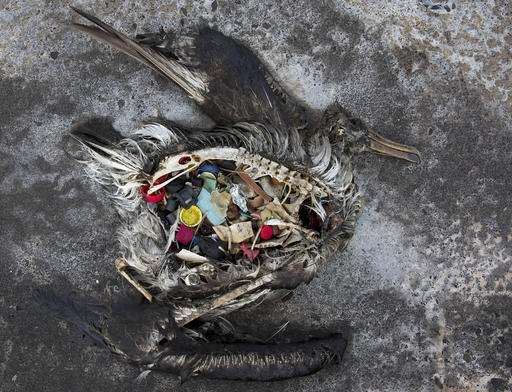
But the GAO noted funding has been slashed from $4 million annually to less than $3 million, resulting in the end of public visitation in 2012.
Officials say more than $1 million a year would be required to reestablish a visitation program, excluding startup costs.
Matthew Brown, Fish and Wildlife's superintendent for the marine national monument, said sustainable tourism is feasible despite the challenges. "It's a very logistically challenging place to do anything," he said.
Its World War II-era structures weren't built to last, and some are coated in lead paint, Fish and Wildlife spokeswoman Megan Nagel said, noting Laysan albatross ingest the paint chips, causing illness.
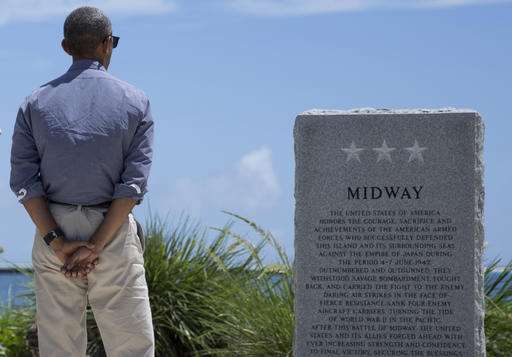
And too many visitors could disturb the delicate ecosystem, Nagel said. For example, some seabirds here are attracted to lights that would be needed for modern accommodations.
Some contend a private company could easily profit from a visitation program on Midway, but "evidence shows that is historical fiction," Guam Rep. Madeleine Bordallo said at the 2014 congressional hearing. "Preservation of historic resources is expensive. If we value it as a country, we should pay for it."
-
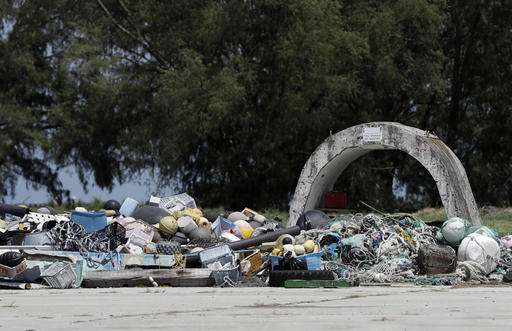
In this Sept. 1, 2016 file photo, plastic and other marine debris is piled on Midway Atoll in the Papahanaumokuakea Marine National Monument, Northwestern Hawaiian Islands, during a tour by President Barack Obama. The Battle of Midway was a major turning point in World War II's Pacific theater. But the remote atoll where thousands died is now a delicate sanctuary for millions of seabirds, and a new battle is pitting preservation of its vaunted military history against the protection of its wildlife. Midway is on the edge of a recently expanded marine national monument. (AP Photo/Carolyn Kaster, File) -
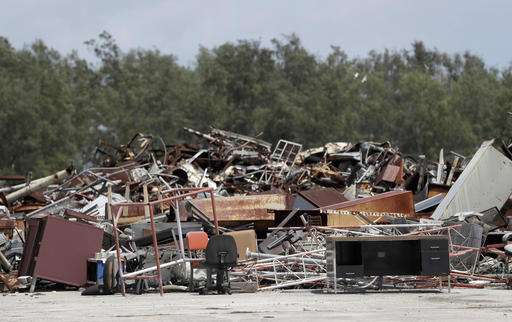
In this Thursday, Sept. 1, 2016 file photo, a large pile of debris is piled up on Midway Atoll in the Papahanaumokuakea Marine National Monument, Northwestern Hawaiian Islands, during a tour by President Barack Obama. The Battle of Midway was a major turning point in World War II's Pacific theater. But the remote atoll where thousands died is now a delicate sanctuary for millions of seabirds, and a new battle is pitting preservation of its vaunted military history against the protection of its wildlife. (AP Photo/Carolyn Kaster, File) -
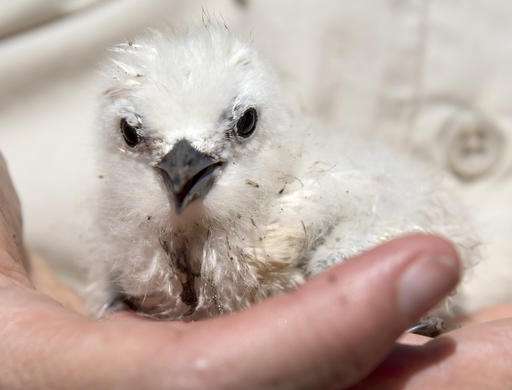
In this Sept. 1, 2016 file photo, a white tern chick is carried on Midway Atoll in the Papahanaumokuakea Marine National Monument, Northwestern Hawaiian Islands, during a visit by President Barack Obama. The Battle of Midway was a major turning point in World War II's Pacific theater. The remote atoll where thousands died is now a delicate sanctuary for millions of seabirds, and a new battle is pitting preservation of its vaunted military history against the protection of its wildlife. The white tern chicks and eggs are brought to an "orphanage" to be hand-reared to protect the population. (AP Photo/Carolyn Kaster, File) -
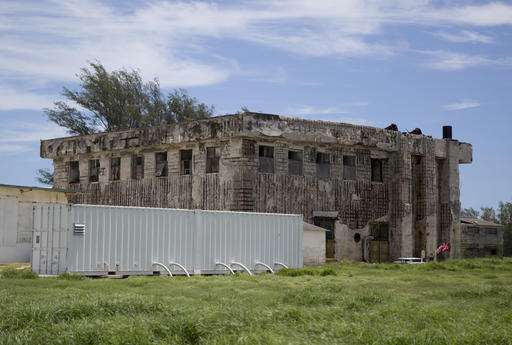
In this Thursday, Sept. 1, 2016 file photo, the power station building, also known as the Cannon Building, is seen on Midway Atoll in the Papahanaumokuakea Marine National Monument, Northwestern Hawaiian Islands, during a tour by President Barack Obama. The Battle of Midway was a major turning point in World War II's Pacific theater. But the remote atoll where thousands died is now a delicate sanctuary for millions of seabirds, and a new battle is pitting preservation of its vaunted military history against the protection of its wildlife. During the attack of Midway, the power station building was bombed and Lieutenant George H. Cannon was mortally wounded. It is eligible for inclusion in the National Register of Historic Places. U.S. Fish and Wildlife Service officials said that the building is not in use. (AP Photo/Carolyn Kaster, File) -
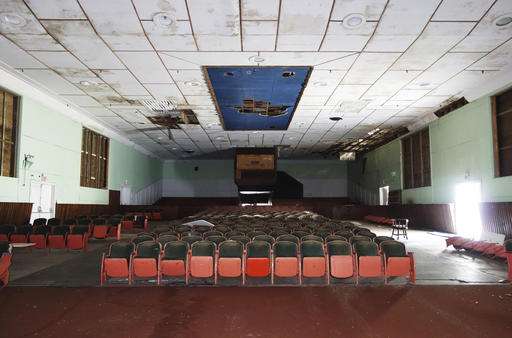
This photo April 17, 2015 photo provided by the United States Government Accountability Office shows the Theater of the Midway Mall, designed by the architect Albert Kahn, and constructed before the Battle of Midway during World War II. The theater is eligible for inclusion in the National Register of Historic Places. The Battle of Midway was a major turning point in World War II's Pacific theater. But the remote atoll where thousands died is now a delicate sanctuary for millions of seabirds, and a new battle is pitting preservation of its vaunted military history against the protection of its wildlife. Six murals were removed from the theater and sent to the Pacific Aviation Museum for preservation and display. (U.S. Government Accountability Office via AP) -
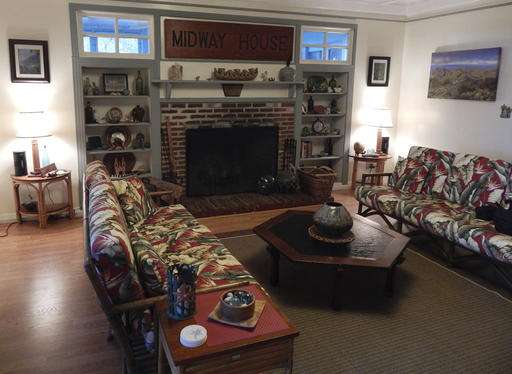
In this April 16, 2015 photo provided by the United States Government Accountability Office, the Officer-in-Charge House, is shown on Midway Atoll in the Northwestern Hawaiian Islands. The Battle of Midway was a major turning point in World War II's Pacific theater. The remote atoll where thousands died is now a delicate sanctuary for millions of seabirds, and a new battle is pitting preservation of its vaunted military history against the protection of its wildlife. The Officer-inCharge House was designed by the architect Albert Kahn and constructed in 1941. It is eligible for inclusion in the National Register of Historic Places. The U.S. Fish and Wildlife Service uses the building to house the refuge manager of Midway Atoll. (Government Accountability Office via AP) -
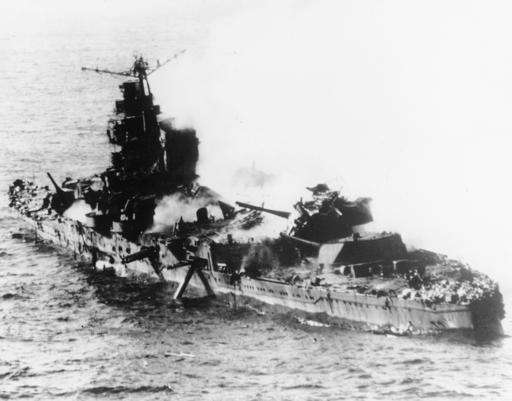
In this June, 1942 file photo, a Japanese ship lies low in the water after being bombed by U.S. Naval aircraft during the Battle of Midway in the Northwestern Hawaiian Islands. The Battle of Midway was a major turning point in World War II's Pacific theater. But the remote atoll where thousands died is now a delicate sanctuary for millions of seabirds, and a new battle is pitting preservation of its vaunted military history against the protection of its wildlife. The public hasn't been allowed to visit the refuge or the battle monuments for years. (AP Photo, File) -
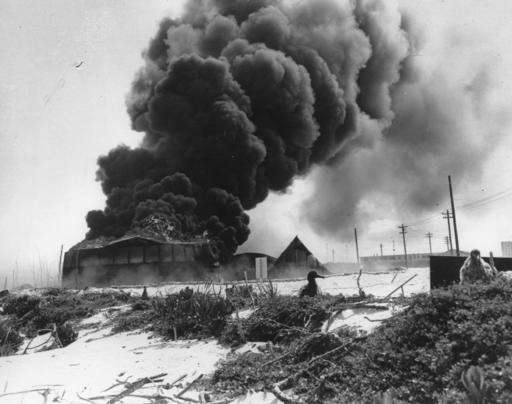
In this June, 1942 file photo, black smoke rises from a burning U.S. oil tank, set afire during the Battle of Midway on Midway Atoll in the Northwestern Hawaiian Islands. The Battle of Midway was a major turning point in World War II's Pacific theater. The remote atoll where thousands died is now a delicate sanctuary for millions of seabirds, and a new battle is pitting preservation of its vaunted military history against the protection of its wildlife. (AP Photo, File)
© 2016 The Associated Press. All rights reserved.


















